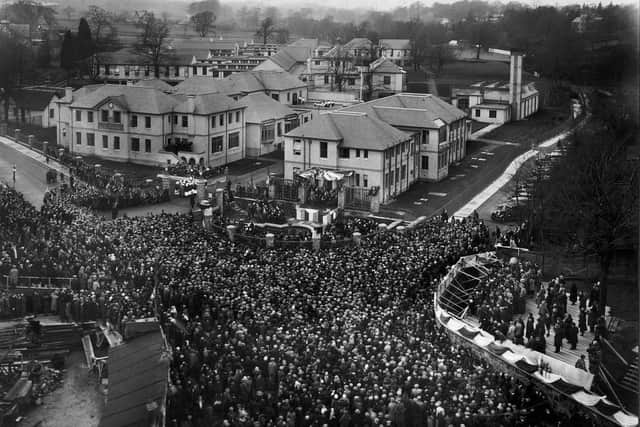Ian Scott: Huge crowds turned out for opening of Falkirk ‘people’s hospital’


A new infirmary was the only answer and on 27th April 1925 over a thousand people crammed into Falkirk Town Hall for the launch of the ‘Great Appeal’.
Unlike the first hospital which had depended largely on the wealth of the middle-class community, the new campaign was the responsibility of everyone.
Advertisement
Hide AdAdvertisement
Hide AdThere followed an astonishing five year spell in which every method of fundraising was employed, and hardly an organisation or individual failed to participate.


If they attended a play or pantomime, part of the receipts went to the fund.
The same applied to football matches and dances, school concerts and bus trips, picnics and whist drives.
There were collecting boxes everywhere – outside hospital wards, in public buildings, in private houses, in shops and business premises.
Advertisement
Hide AdAdvertisement
Hide AdThe impression which comes through from newspaper articles, concert programmes and souvenirs is of a great collaboration of all the people in securing ‘their’ Infirmary.
Every square yard of the site, every brick of the buildings, every stick of furniture and equipment and every penny of wages and salaries would be provided by the people.
A glance through the Herald in 1926 and ’27 reveals a frenzy of fundraising activity. One might for example, enjoy ‘The Merchant of Venice’ at the Dobbie Hall, ‘Floradora’ in the Grand Theatre, or ‘She Stoops to Conquer’ in the Town Hall.
There was a ‘Fancy Fair’ and ‘six penny bazaar’ in the YMCA hut, ‘Mr Martin's Orchestra Dance’ in the Gymnasium, Camelon, and ‘Music in the Garden’ at Arnothill.
Advertisement
Hide AdAdvertisement
Hide AdFor sporting types there were football, cricket and tennis competitions as well as the chance to see a ‘Great Boxing Gala in Jim Paterson's new and commodious Pavilion’ to see ‘a four round contest between Spowart's midgets’ along with Falkirk's own ‘Fatty Wells, Young Connell and Butcher Anderson’.
There were road races, grand penny trails, watch-winding competitions, highland gatherings, popular lectures, community singing, jumble sales and silver paper collections.
There were official ‘Infirmary Weeks’ with great carnivals of students in fancy dress and decorated floats parading through the streets of the town. The list was endless.
By the time the Duchess of Montrose cut the first sod at Gartcows in November 1926 the fund had reached £90,000.
Advertisement
Hide AdAdvertisement
Hide AdThe modern building designed by William Gibson, whose mother was the founder of the old infirmary, provided for 120 beds paid for by the community and a Maternity Ward funded by the Government.
The patients moved in at the beginning of 1931 and a year later (and 90 years ago this week) Prince George declared the building open in front of 20,000 people naming it ‘Falkirk and District Royal Infirmary’.
It had cost £120,000 – nearly £3 million by today's standards – and was opened free of debt.
Now serving as the community hospital it continues to play a vital role and will always remain the ‘people’s hospital’.
Thank you for reading this article on our free-to-read website. We're more reliant on your support than ever as the shift in consumer habits brought about by Coronavirus impacts our advertisers.
Please consider purchasing a subscription to our print newspaper to help fund our trusted, fact-checked journalism.
Comment Guidelines
National World encourages reader discussion on our stories. User feedback, insights and back-and-forth exchanges add a rich layer of context to reporting. Please review our Community Guidelines before commenting.
